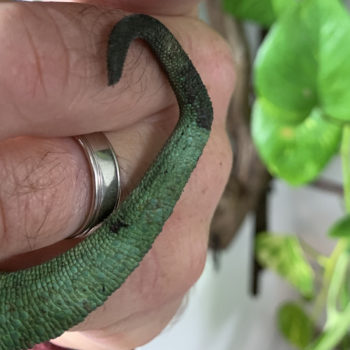Tail Damage
Description
A chameleon’s prehensile tail is one of its main tools for negotiating the trees and branches. Thus it is vulnerable to a number of dangers.
The biggest danger in captivity is the keepers inadvertently injuring the tail while picking the chameleon up. The chameleon feels secure when its tail is able to wrap around an object as this is their anchor. Therefore, the tail is always searching for something to grab onto – especially when you are pulling it out of the cage.
Tails are also the target of bullying in cohabitation situations. This is often seen in babies that are brought up together. One or more of the chameleons will start biting the tails of their cage mates. Very rarely, chameleons have been known to bite their own tails. This has been attributed to the chameleons being in too small of enclosures, but is rare enough that we are still learning why a chameleon would do this.
Symptoms
If you suspect that a tail is damaged then you need to evaluate whether it is a surface injury or if there is internal damage. Internal damage will show itself as discoloration of the skin on the surface, kinks in the tail, and part of the tail being limp and unresponsive.
The origin of this injury is unknown. This female Jackson’s Chameleon was attacked on the side of her outdoor cage. Presumably this is major bruising from falling. The entire back of the tail was black, but still responsive. There was no sign of break or damaged tissue internally. After a couple days the black had disappeared and the tail was fully functional.
This is what a nipped tail looks like. The female panther chameleon had her tail tip bit off by a sibling. Thus the danger of cohabitation. I received this female and two other withs tail tips bitten off for my breeding projects. Great deal. But this illustrates the effects of poor husbandry. And what can occur when raising baby chameleons together.
This Veiled Chameleon was observed chewing on his own tail. This is a very rare occurrence and it is suspected that this behavior is brought on by being kept in small cages. Perhaps they are forced into unnatural positions that present their tail in ways that are not expected or perhaps there is a certain mental effect that results from small spaces. Although we could certainly create a story around this, the fact is that most chameleons in enclosures too small from them do not resort to eating their tail. This does not rule out cage size as a contributing stress factor that pushes some over the edge, but I caution the reader that we simply do not have enough information to make conclusions – only guesses that need to be explored. Thankfully, this condition is rare. If you experience this in your chameleon please share the conditions to me at bill@chameleonacademy.com. Your input will be compiled anonymously.

This is a baby panther chameleon just doing what baby chameleons do. You can see how delicate the situation would be if the keeper decided to bring this baby out and did not notice what it was doing with its tail.
Treatment
Treatment of tail injuries depends on severity. As is usual in a case like this, check with your veterinarian. If an extreme case requires the amputation of the tail your chameleon will still have a full life ahead of him without the tail. Although chameleons rely on their tails for survival, your captive conditions will ensure that he does not need every advantage to survive.
Husbandry Correction
The only husbandry correction that can be done is to prevent the types of tail injuries that come from removing the chameleon from the cage and to be very careful when closing the door. I have seen, a couple of times, kinks in a panther chameleon tail that perfectly match the width of a chameleon cage screen door frame.
Separating babies and keeping chameleons in individual cages is the way to avoid tail biting. There is no way to tell when an individual will turn to tail biting of their cage mates or even themselves. But this seems to strongly correspond to inadequate caging conditions. Keeping chameleons singly in large enclosures solves these problems.












